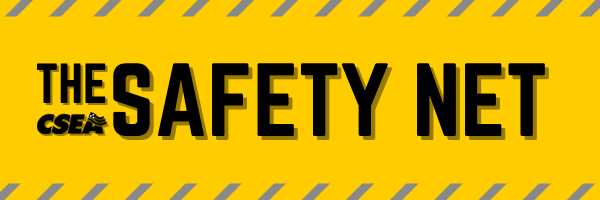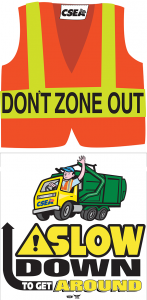
March 2023 Volume 2 | Issue 9:
Gearing Up For Spring Hazards
& Spreading Awareness
ANNOUNCEMENTS
Triangle Shirtwaist Factory Fire Memorial – March 30
The Triangle Shirtwaist Factory Fire Memorial’s 18th Annual Award Reception and Scholarship Fundraiser will be held March 30 from 6 p.m. – 8 p.m. at the RWDSU Union Hall, 307 Seventh Ave, 5th Floor, New York, NY 10001 (Only steps away from Penn Station). Enjoy a night featuring special honorees, awards, cocktails and hors d’oeuvres. Learn more at https://trianglememorial.org/annual-event/.
MEMBER ALERT
Stand Up For Safety!
Has your employer posted an Annual Summary of Injuries & Illnesses at your workplace?
Every year, employers must sign and visibly post the Summary of Work-Related Injuries & Illnesses in your workplace fromFebruary 1 to April 30.
*Send us a picture of the summary posted in your workplace to receive a prize!
“DEAR BERNIE” ADVICE COLUMN FOR SAFETY SOLUTIONS
Write to “Dear Bernie” with your questions or concerns relating to workplace safety and health and receive advice from our OSH professionals!
*Submissions will be published anonymously.
SAFETY QUOTE
Safety is a common denominator across all aspects of life… It is not a matter for industry, it is a matter for humanity.
– Doug Bourne
OSH NEWS HIGHLIGHTS
Construction Company Operator and Foreperson Convicted in Connection With Laborer’s Death in Brooklyn Wall Collapse
Kings County District Attorney’s Office | March 2, 2023
Ignored Workers’ Safety Concerns, Industry Protocols, and Concerns
Expressed by Adjacent Property Owners; Victim Was Buried Under Debris
Prison Time for Killing Worker in Trench Collapses
Confined Space: A newsletter of workplace safety and labor issues
Jordan Barab | March 7, 2023
“It is no secret to anyone who has followed my rants for the past couple of decades that killing workers in trench collapses really pisses me off. Workers die all kinds of ways every day in this country, but the hazards of trenches are well recognized, and preventive measures are well known — and required by law.”
https://jordanbarab.com/confinedspace/2023/03/07/jail-trench-collapse/
Senators Introduce Resolution Recognizing NWZAW 2023
Resolution lists steps for motorists to practice work zone safety
ATSSA | March 15, 2023
https://www.atssa.com/Blog-News/ATSSA-Blog/senators-introduce-resolution-recognizing-nwzaw-2023
READER’S RESPONSE
Let’s hear about your experiences and involvement with safety and health at your workplace! Respond to the prompt below and get featured in the following month’s issue.
*Participants will receive a prize. We look forward to hearing from you!
February’s Prompt:
What topics covered by the Safety Net have been most helpful to you and why? Also, let us know what type of content you’d like to see in upcoming issues! What type of information or content do you prefer and/or enjoy most?
Reader’s Response: CSEA member John L. writes:
I work at the DEC and members can come back with tick bites. I’ve been hearing a lot about tick-borne illnesses. Can you get us more information about that?
John,
Thank you for your response on this important and relevant issue. You are right to be concerned about ticks and tick-related illnesses. Most experts predict that this year will be a very bad tick season. There are about 30 species of ticks in New York State, nearly 10 of which bite humans, and of these, only four transmit disease to people. Check in next month and we’ll provide more information about controlling ticks at work. In the meantime, here is a link for more information and our fact sheet on ticks and Lyme disease.
NATIONAL WORK ZONE AWARENESS WEEK: APRIL 17-21
Work Zones are a Sign to Slow Down
National Work Zone Awareness Week (NWZAW) is an annual spring campaign held at the start of construction season to encourage safe driving through highway work zones. The key message is for drivers to use extra caution in work zones.
Everyone plays a role in work zone safety. When driving through a construction work zone, slow down and pay attention. There may be a flagger directing traffic and/or construction workers near the flow of traffic.
Help Raise Awareness: CSEA’s Don’t Zone Out & Slow Down To Get Around Materials
Order your free supply of Don’t Zone Out & Slow Down To Get Around magnets and window clings while supplies last!

SAFETY PROGRAMS: 15 THINGS EVERY UNION LEADER SHOULD KNOW
- The twin goals of a union safety and health program are to improve working condition and to build the union. They are equally important. In fact, you can’t do either one well unless you do both.
- Management has different goals, even enlightened management. They may care about safety in its own right but are probably more concerned about workers’ compensation costs – and building the union is never one of management’s goals
- What you do with the employer on safety and health is a form of collective bargaining. Even if you don’t see it that way, they do.
- Safety and health isn’t a technical issue. Technical knowledge helps, but there are plenty of places to get technical information. Strategy and organization are much more important.
- Every local union needs a union safety and health committee. You should set one up even if you don’t have a joint safety and health committee. You don’t need the employer’s permission to establish a union committee.
- It’s also good to have a joint safety and health committee with representatives from the union and from management. The joint committee is a good way to resolve safety and health problems.
- Even if you have a joint committee, you still need a union committee. The union committee can be comprised of union representative on the joint committee, or a larger group.
- The union members of the joint committee should meet by themselves as often as they meet with management. You need separate meetings to set union priorities and plan strategy. Can you imagine what would happen if your negotiating committee met only with the employer at contract time and never by itself?
- You should never, ever allow the employer to appoint your safety and health representatives, veto the union’s choices, or dismiss your representatives from their union positions. Never. Ever.
- Union safety representatives should think of themselves as organizers who promote safety and health in a way that builds the loyalty and commitment of your membership. That means involving the membership whenever you can. It also means good communication with your membership, both written and by word of mouth.
- “Behavior” contributes to some accidents, but hazards cause all of them. It’s easier to fix hazards than to change human nature.
- Safety programs that focus on behavior tell our members that they are the problem. In fact, union members and their union are the solution.
- The best way to find hazards is for union safety and health representatives to talk to every worker about his or her job, and how to make it safe and easier. It’s even better to enlist that member in pushing for improvements.
- What’s the best way to build the union through safety and health? See #13 above.
- You’re not alone. You have lots of resources through CSEA. Every region has an occupational safety and health specialist. CSEA offers union safety and health committee training and Labor/Management Committee training.
MEMBER SPOTLIGHT
What’s your story? We’d love to hear it! Share your content, which could simply be a safety-related quote/slogan, meme, or photo. You may also submit your own written content; tell us about a particular experience, success story, or give a shoutout to a CSEA member/committee/local, or any other noteworthy recognitions! Please note that all content must be original or attributed to the original source.
*Be featured in the Safety Net or choose to do so anonymously. All participants receive a prize!
GET INVOLVED
Be an Advocate for Safety: Help Rebuild CSEA’s Safety Network!
Download/print the Safety Net newsletter in bulletin format: cseany.org/safetynet
Show us a photo of the newsletter bulletin posted in your workplace to receive a prize!
*Send photos to bernadette.foley@cseainc.org.
GET FEATURED IN THE SAFETY NET
We love hearing from you! More importantly, readers truly enjoy and connect with member driven content. Our goal is to gain visibility and strengthen CSEA’s safety network – what better way than to hear from one another and learn in the process?
Send in your content by responding to any of the following newsletter columns: “Member Spotlight,”“Dear Bernie,” or “Readers’ Response.”
All who participate will receive a prize!
Submissions can be emailed to bernadette.foley@cseainc.org.
MEMBER RESOURCES: OCCUPATIONAL SAFETY & HEALTH
Materials & Publications
View/download – A-Z list of fact sheets: cseany.org/safety-resources
Request Free Prints – Publications Order Form
Workshop Trainings & Webinars
View/Watch – webinar trainings: cseany.org/osh-webinars
CSEA Occupational Safety & Health (OSH) Specialists
Have a general safety concern?
Contact your OSH Specialist here: cseany.org/member-support
WORKERS’ COMPENSATION
Hurt at Work?
CSEA endorses the law firm of Fine, Olin and Anderman
Get started now by clicking https://www.foalaw.com/csea-members/
Or call at 855-637-1207

